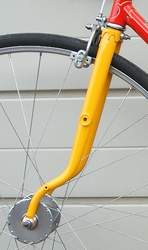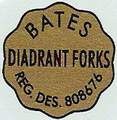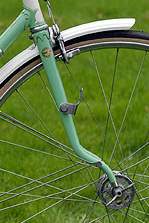Bates Cycles - Diadrant forks
Posted: Monday 08th June 2020
The Diadrant front forks with their distinctive double curve in Reynolds 531 steel-alloy are the trade-mark of a Bates. These were developed at about the same time as the Cantiflex frame (1935) and the idea was to create a straighter fork for a lively feel, but with the addition of an extra curve to help damp out road shocks. A useful addition on a frame that is stiffer than the norm.

Finalising a design that could be registered proved easier said than done. The initial design – which was advertised as the Diadrant fork in Cycling of December 1935 – was in fact quite different to the type we know now and was changed apparently because the early prototype fell foul of existing patents held by Dunelt. This design had each blade going downwards as normal, but then curved backwards before curving forwards again. This would have provided a higher degree of flex.
By the time the first production Diadrant fork arrived it looked a very different animal. This time the fork extended downwards in the usual manner but then curved forwards and then down again, forming a distinctive double curvature in the lower section.

In fact West London cycle makers Dayton had used a similar design approach (but with wider radius curves) and this may have led to difficulties in registering the design. This was achieved, however, and Bates found themselves with the Diadrant front fork. The new design had the added bonus of making a Bates machine instantly recognisable even at a distance or from pictures in the cycling press This was a vital point for marketing in an age where brand advertising on racing cyclists’ clothing was banned by the organising body.

So does the Diadrant fork actually offer any genuine benefit over a conventional front fork? Maybe. Some Pinarello machines employ a similar double curve design for the front forks used for their top-end models. Here, the material is carbon fibre rather than steel but the principle is the same. The computer boffins at Pinarello claim that in computer simulations the double curve design provides ten per cent greater absorption in a vertical plane but with a five per cent higher level of stability in cornering and braking compared with a conventional shaped fork.
To bring this all down to earth, there is one story that suggests that the Diadrant fork design came about by accident. The tale goes that the Bates Brothers were asked to produce a carrier bike for the local butcher and they incorporated a double bend in the fork to accommodate the shape of the front carrier basket. On riding it, it was said that this design of fork gave improved rider comfort so Horace Bates set about registering the design. It’s probably not true, but a nice story nonetheless.
Posted: Monday 08th June 2020
This article appears in the following categories.
Upcoming Events
Whether you are looking for a gentle social meet up, or a 100-mile ride browse the community’s upcoming events and plan your next weekend outing.
